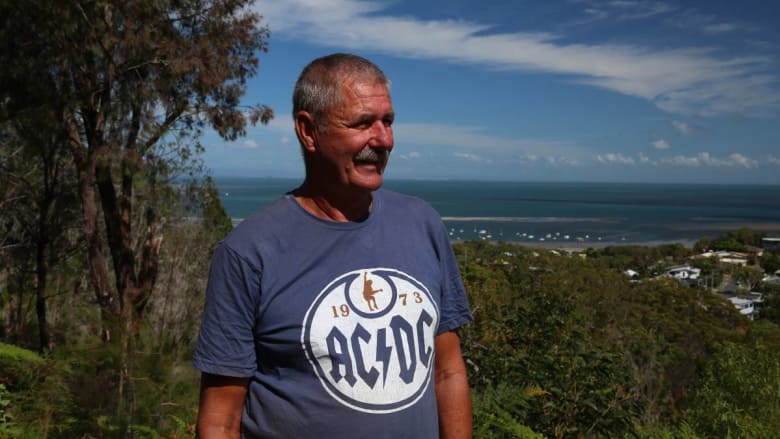|
Every day Dave Thelander of Dunwich shows people around his beloved North Stradbroke Island.
And when Sibelco closes its mine on the island in 2019, there will be so much more to show.He talks about exploring Black Snake, Blakesley and Native Companion lagoons. He dreams about eco lodges, new swimming spots and walks along boardwalks. “It will be wonderful without the mines. The whole island will open up. There will be so much more to see and it is the island’s beauty that will be its salvation,” he said.“If you think about it, you can’t go to see the mine, but you can go to see a national park. The people there have known for years about the closure and yes, they will lose jobs, but most people would have worked something out by now,” he said. A former electrical supervisor at the Gordon mine, Mr Thelander, 60, known to all as Barefoot Dave, started Straddie Kingfisher Tours (named after his children Steven, Kim and Tracy, STK) 18 years ago. His venture brings predominantly international tourists to the island and he delights in sharing its diverse attractions.“Every day, I see animals, I share this environment and I meet new people. I see the best in people. They are always here to have a good time and every day I get to see my favourite part of the island. That’s the part where I am at that moment. Tourism is the island’s future, particularly eco tourism,” he said. Mr Thelander talks about the first time he came to the island, then to visit his uncle who was a fisherman in 1966. He shares his stories as an altar boy at St Pauls. Interspersed with this conversation are salient facts about the island.Did you know, for example, that goannas have glands of poison (there are quite a few at Brown Lake) and that grass trees, prolific throughout the island, grow at one metre every 100 years and that the patterns on a scribbly bark tree are caused by moth larva. He points out hop bush and she oaks and talks about the 253 varieties of bird, three of which were logged by his brother Andrew. Mr Thelander knows his island facts, facts about sighting 320 whales off Point Lookout on July 12 last year and that the dolphins have lunch at Amity Point before heading to Tangalooma on Moreton Island for dinner. He knows that there is a koala for every resident on the island with the populations almost matching (2000 koalas to 2100 permanent residents). The people population swells during the Christmas season with 12,000 full beds on the island and more with day trippers who come to the island at 150 people per hour.He knows that northerly winds bring seaweed and blue bottles. He knows that transport adds 30 per cent more to the cost of a house and that supermarkets online is the holiday makers' friend. He points out in one sweeping gesture the fact that it’s just 32km between the most easterly point in Australia (Byron Bay) and the most easterly point in Queensland (Point Lookout), the two points clearly visible along Main Beach, situated on the second largest sand island in the world (Fraser is the largest and 5.5 times larger). His stories are also about the people, about the 8000 massed graves of typhoid sufferers and the ship’s doctor who attended them (George Mitchell, died at 25) at the Dunwich cemetery, Queensland’s second oldest cemetery. He talks about the ship that changed the direction of the tide and split an island in two when it was blown up to hide contraband between north and south Stradbroke. He takes his people along the Tripod track which cuts across the island and was created in the second world war from which to spot Japanese submarines. In the end, the radar was installed at Point Lookout and there is a plaque to mark the spot. Along the way, he waves at fellow motorists. His is a familiar face on the island where he also works as a marriage celebrant, a rural fire fighter and delivers the papers off the first barge. He has a broad vision for the island. “Imagine Dunwich with the walkways of Redcliffe and a wading pool like Wynnum. I see a Fisherman’s wharf. Boaties could tie up and get a paper, a cold beer and some fish and chips. They would come in their millions. We just have to provide things for people to do,” he said. “Did you know that of the Queensland population alone only 4.4 per cent have been to Straddie? That means there are 95.6 per cent who have yet to come.” That’s a lot of people to show an island which is about to open up with the closure of the mine in 2019. “The sooner it becomes a national park the better. Once the mine closes, the healing process will come together quickly,” he said. “The day I retire is the day I can’t put the esky on the roof.” This article first appeared at Redland City Bulletin. |
AuthorPosted by "Barefoot Dave" who just loves telling you all about this Island Paradise we call "Straddie". Archives
March 2019
Categories |
Straddie Kingfisher Tours Copyright 2023


 RSS Feed
RSS Feed